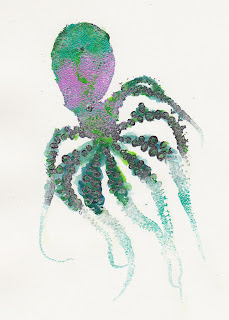I didn't know that some embossing inks are translucent and others are opaque. That does make a difference as the translucent powders allow the color of cardstock and ink to show through, while the color of an opaque powder is that color no mater what. I have many different colors of embossing powders, but I bought a pack of Fred's powders because I knew they were translucent. Many stores sell Fred Mullet stamps, but they are also available online: Fred Mullet
 |
| I had the smaller fish print stamps and bought the larger one after taking Fred's class. I think I can make an underwater scene with these making a larger, frameable piece of art. |
rubber stamps
black and white pigment inkpads
a range of embossing powders
watercolor paints
brushes
cocktail straw with the end cut on an angle
tee tiny spoon (like the type used to taste ice cream)
2 cups of water, one clean and one for washing out brushes
cardstock
embossing gun
box to catch embossing powders in
paper towel or TP, which Fred calls '"technique paper"
porous sponge car washing sponge or a sea sponge
Before you begin stamping, decide which colors of embossing powders you want to use. You need a smooth matte cardstock, not glossy. This can be white, tan, or other pale colors. Later you may want to experiment with darker colors and bleach.
Begin by inking your stamp. For a fish, use black ink beginning just above the fish's lateral line on the stamp. Then stamp the bottom portion of the fish with wihite ink. For a plant/flower you can yoose black towards the middle and white towards the edges.
Now in the section where white and black meet, take your sponge and pounce with a zigzaging motion - on the white then on the black, then back on white etc. This blends or eases the transition from black to white.
Next, the spot application of embossing powers which Fred says is sort of like painting with plastic.Use your fancy applicator to deliver a small amount of embossing powder in specific ares of your stamped image. Use one color possibly 2-3 but don't get carried away, because you have lovely watercolors to provide additional soft colors. Hold the straw close to the paper and very gently shake out powder.
Use a translucent/very light color of embossing powder over the white ink and some of the black as well. Use your tee tiny spoon and hold it up away from the paper, gently shake so that the powder floats to the paper.
This the part that is called the 'dance.' Hold your cardstock in one hand over the box and with the other hand, gently tap the underside so that the powders dance on the surface and mingle into other areas a bit. Tap off the excess, then emboss. If you hold your paper up even with your line of sight, you can more easily see just when the powder melts, then move on to another area. That way you don't overheat/burn your powder or miss areas causing them not to be embossed at all.
The last step involves water colors! We used paint in class, as did I in the samples in this tutorial. However, you could use watercolor markers and a blending pen if you like. Don't over-wet your paper or it will buckle, but at the same time do add water to your paint before adding to the cardstock so that it will have that watercolor look.
 |
| For these flowers, I chose to place my darker areas towards the center and the lighter areas towards the edges. |
 |
| On these samples, I used green embossing powder on the stem, but you could use watercolor there as well. |
 |
| Be sure to leave or add a touch of white in the eye for more realism. |
















.JPG)
.JPG)
.JPG)































